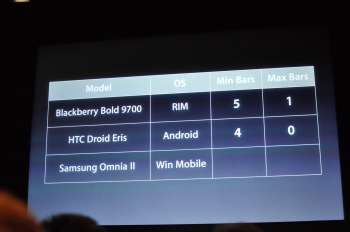Apple's iPhone 4 fallout: The smartphone "industry" fires back


On stage at Friday's invitation-only press conference, Jobs didn't go right into his defense of the iPhone 4 and his dismissal of the hoopla as something blown out of proportion. Instead, he kicked things off by talking about smartphones made by rivals RIM, HTC and Samsung and how, as an industry, they all have antenna and reception issues.
I can almost hear the "What the... ?" from the offices of Research In Motion co-CEOs Mike Lazaridis and Jim Balsille as they saw their product being put under the microscope by Steve Jobs. Here's the official reaction, posted on the All Things D Digital Daily blog:
Apple’s attempt to draw RIM into Apple’s self-made debacle is unacceptable. Apple’s claims about RIM products appear to be deliberate attempts to distort the public’s understanding of an antenna design issue and to deflect attention from Apple’s difficult situation. RIM is a global leader in antenna design and has been successfully designing industry-leading wireless data products with efficient and effective radio performance for over 20 years. During that time, RIM has avoided designs like the one Apple used in the iPhone 4 and instead has used innovative designs which reduce the risk for dropped calls, especially in areas of lower coverage. One thing is for certain, RIM’s customers don’t need to use a case for their BlackBerry smartphone to maintain proper connectivity. Apple clearly made certain design decisions and it should take responsibility for these decisions rather than trying to draw RIM and others into a situation that relates specifically to Apple.
Well said, gentlemen.
It was one thing for Apple to lower its standards to those of "the rest of the industry." As I said in a post on Friday, Apple has always taken pride in offering a premium product to customers willing to pay a premium price. That set it higher than the others. But clearly in the iPhone game - and now in the crisis management game - Apple is looking more like a rookie, instead of a global powerhouse.
Related: Did Apple iPhone 4 flap delay long-rumored Verizon Wireless debut?
I mean, really, did anyone there think that RIM and the others weren't tuning in to coverage of Apple's press conference and would just be OK with Jobs trying to shift attention away from the iPhone's woes by deflecting attention? Equally so, did Apple really think that the public was going to largely buy into its gospel about antenna shortcomings that it spewed on Friday? There are plenty of others out there - including the same rivals who responded to Apple's latest press event - who have studied antenna technology and can easily offer a counter-thought to Apple's statements. Nokia, for example, issued this statement:
Antenna design is a complex subject and has been a core competence at Nokia for decades, across hundreds of phone models. Nokia was the pioneer in internal antennas; the Nokia 8810, launched in 1998, was the first commercial phone with this feature. Nokia has invested thousands of man hours in studying human behavior, including how people hold their phones for calls, music playing, web browsing and so on. As you would expect from a company focused on connecting people, we prioritize antenna performance over physical design if they are ever in conflict.
Former colleague and pal John Paczkowski at Digital Daily blog posted all of the statements from the companies if you want to read them in full. Some are softer - Samsung is also an Apple partner, after all - while others were stronger. HTC and Apple are across the table from each other in a patent legal battle, for example.
All the smartphone makers seem to know that there are challenges that come with antenna technology and that's why they choose to not put their antennas on the outside, especially in an area where it will be impacted by the way people hold the device. Just because Apple chose to put design first and is now seeing that decision backfire, that's no reason to try to mask that bad decision with a diversion tactic.
Everything else about the iPhone 4 may be better than anything else on the market. But that antenna makes the iPhone 4 a poorly designed device - plain and simple.
Other coverage:
- Jobs: “There is no Antennagate”
- How will ‘Antennagate’ affect Apple’s consumer perception?
- Apple’s ‘Antennagate’ mea culpa - free case until Sept 30
- Poll: Has the antenna issue influenced your iPhone 4 purchase?
- Apple update: No recall coming; Company denies antenna warning was issued
- 54% say Apple should do a recall of iPhone 4